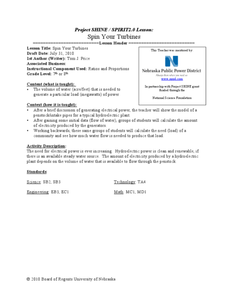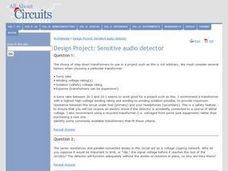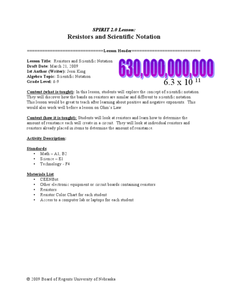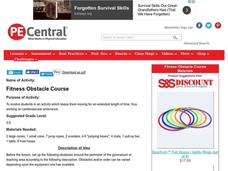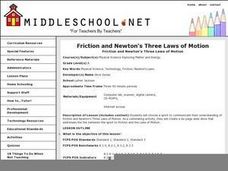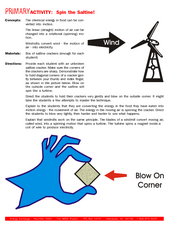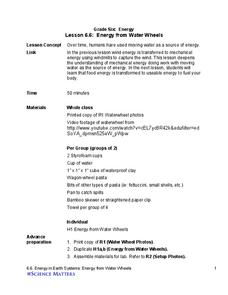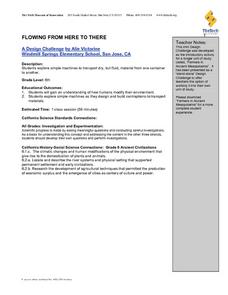Equality and Human Rights Commission
Learning area 2: Challenging Stereotypes and Discrimination
Six powerful and eyeopening lessons provide scholars with activities designed to challenge stereotypes and discrimination. The unit provides reading material with which pupils read and discuss. Grand conversations lead to physically...
Curated OER
The Math of Light
Investigate light intensity, illuminance, and power consumption of different light source.Compare the efficiency of light bulbs then create a persuasive advertisement about it.
Curated OER
Spin Your Turbines
Students relate electrical power and how it works to math. In this geometry lesson, students analyze how a hydroelectric plant works and calculate the amount of electricity that is produced by a typical generator. This lesson uses...
Curated OER
Who Turned on the Lights?
Seventh graders discuss how energy is transformed from one form to another. In this physics lesson, 7th graders design and build their own hydro generator. They identify the factors that affect its energy production.
Curated OER
The Science of Swinging
Students learn how a pendulum works in the concept of an amusement park ride. In this pendulum lesson, students are introduced to Newton's first law of motion and how it works in an amusement park ride. Continuous motion and inertia are...
Curated OER
Design Project: Sensitive Audio Detector
In this physics worksheet, students answer 5 conceptual questions about the sensitive audio detector they built. They analyze the component of their circuit.
Curated OER
Resistors and Scientific Notation
Students explain the importance of scientific notation. In this physics lesson, students determine the resistance of resistors using the colored bands. They compare and contrast scientific notation and resistor band notation.
Curated OER
Build and Test Your Car Continued
Students create and build cars to race in class. In this physics lesson, students calculate the speed using distance and time information. They evaluate their design and make adjustments when needed.
Curated OER
Fitness Obstacle Course
Students run through an obstacle course to practice jumping, vaulting, pull-ups, and other physical endeavors. The obstacles are set up in a gymnasium, and students rotate through each task.
Curated OER
Friction and Newton's Three Laws of Motion
Students work in small groups to create a power point illustrating Newton's Laws of motion as related to a sport of their choice.
Curated OER
Ionocraft Lifter
Students explore the different types of lifters through a series of activities. In this physics lesson, students explain the mechanics involved in the lifter designs. They compare aluminum versus zinc lifters.
Curated OER
Magnets, Electromagnets, and Motors
Learners investigate the concepts of magnetism and its properties. They construct a magnet and test foods for iron content. Then students define the use of a motor and make their own electric motor while working in small groups. Then...
Curated OER
PHYSICS LESSONS
Students study the concept of electricity, what an electric current is and its relationship between voltage and resistance.In this electrical lesson students solve problems using Ohm's law, and research alternative sources of electricity.
Curated OER
Solar Car Series: During what part of the day can t most Sun power be collected?
Students participate in an outdoor activity in which they make direct but safe observations of the Sun. Students use a solar cell and voltmeter apparatus to collect data on the amount of DC voltage produced by the solar cell during a...
Curated OER
Powering a Green Earth
Students compare and contrast renewable and nonrenewable energy. In this environmental science instructional activity, students discuss the importance of going green. They identify the different components in a power grid system.
Curated OER
Flower Power
Students view examples of Robert Harris' artwork to identify and describe the ecosystems in them. In groups, they work together to discuss how ecosystems breakdown and create solutions to keep this from happening. To end the lesson,...
Curated OER
Spin the Saltine!
Students investigate chemical energy. In this physical science lesson, students blow on saltine crackers to demonstrate how chemical energy in food can be converted to motion. Students compare the saltine cracker experiment to how...
Curated OER
Lemon Batteries Revised
Fifth graders investigate how chemical energy in food and batteries is potential or stored energy. They discuss how batteries function, and create a class list of different forms of energy. Students then create a lemon battery that...
Curated OER
Fitness Notes - Weight Training
In this resource, the fitness notes cover the five principles of fitness, the principles of training/exercise, and cardio-respiratory fitness. The weight training notes cover the principles of weight training, proper techniques, and the...
Science Matters
Energy from Water Wheels
Historians believe the first vertical water wheel was invented in Rome during the Augustan Age. The sixth lesson plan in the series of 10 has scholars experiment with designing their own water wheels. Through testing various pastas and...
KOG Ranger Program
Use It Safely!
Campfires are not the only way that forest fires start. In a worksheet and word matching activity, young campers learn about common fuel and heat sources that, when combined, can be the spark to a dangerous and harmful forest fire.
Curated OER
Flowing From Here to There
Sixth graders discover how humans modify their environment. They work together to design their own simple machine to transport materials. They record observations and suggest modifications.
Curated OER
Healthy Heart Night
The idea of having a Healthy Heart Night at your school is a fabulous thought. Here are a few ideas that detail was done at one elementary school. It would take a lot of organizing to make it happen, but seems well worth the effort. This...
Acoustical Society of America
Anatomy of a Wave
Pair physical science learners up, and have one describe a transverse wave while the other blindly attempts to draw it. Then reveal an actual diagram and explain the different parts of the wave: crest, trough, wavelength. Though most of...




